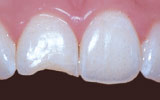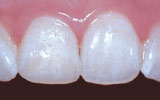The Field-Side Guide to Dental Injuries
A Guide for Parents, Athletic Trainers, Caregivers, Teachers and... Patients!
(Continued)
Less Urgent Treatment — Within 12 Hours
Teeth broken or chipped but not moved from their original position
Permanent Tooth
 |
 |
| An example of how broken or chipped teeth can be restored using bonding tooth colored materials. |
| Photos provided by Dr. Doug Lambert |
Chipped or fractured: These teeth will be sensitive to touch, hot and cold, and should be treated as soon as possible. However, treatment of a pulp (nerve) exposure 12 or more hours after a crown fracture will not affect long-term outcomes. Restoration (filling or replacing missing tooth fragments with restorative materials) may require local anesthetic (numbing the tooth) before treatment. If tooth fragments can be found, they may be reattached to the crown of the tooth by bonding.
Why: Teeth with crown fractures (the most common traumatic injury) with or without pulp exposure are sensitive to hot and cold, but can be treated within 12 hours without any effects on long term outcomes. In fact, pulp exposures can be treated by a pulpotomy (partial pulp removal) technique and sedative/reparative medicaments used, calcium hydroxide or white MTA (mineral trioxide aggregate) for up to two days without long-term effects.
Incisors (front teeth) can be temporarily restored with special cements or the dentist may reattach the original tooth fragment (by bonding) or restore appearance and function with composite (bonding) resin. Every effort should be made to find the tooth pieces or fragments.
A tooth loosened or tender to touch: No dental treatment may be required, but the dentist will collect baseline clinical and radiographic (x-ray) information to monitor the tooth or teeth.
Why: Teeth that are loosened or tender to touch are not treated nor are root fractures unless there is displacement of the tooth. Apical (root end) and mid-root fractures will heal without splinting whereas root fractures higher up near the crown and gum line pose a variety of problems and complicated treatment options.
A dentist will need to assess the vitality of the dental pulp, whether it is still living or has died as a result of trauma, at 6 weeks and then periodically, usually in association with recall visits.
Primary Tooth
Chipped or fractured: Chipped or injured primary teeth are generally managed in much the same way as permanent teeth; treatment will depend on the extent of injury and damage to the tooth. Treatment of fractured primary teeth will depend on the nature and position of the fracture, and the proximity of the injured tooth to the permanent underlying tooth, which will ultimately replace it. If a fractured primary tooth cannot be saved, the dentist or pediatric dentist will make the decision to remove it, in consultation with parent(s) or caregiver.
A tooth loosened or tender to touch: No treatment may be required, but the dentist will collect information to monitor the tooth, to ensure that there is no damage to the underlying permanent tooth.
Why: Teeth loosened, tender to touch or have the root fractured are not treated unless there is displacement affecting the underlying permanent tooth. Primary teeth are more likely to be removed to ensure the health of the underlying tooth with consideration for a space maintaining appliance until the permanent tooth erupts into the mouth.

